Exploring Long Sleeve Wet Shirts for Kiteboarding
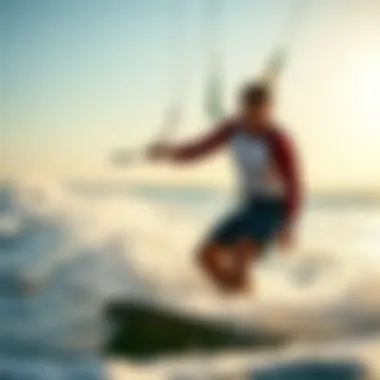
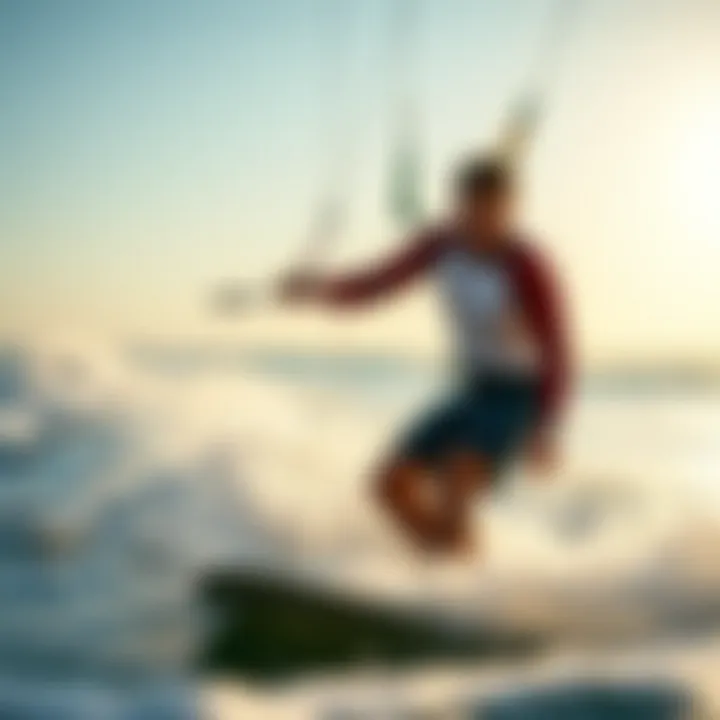
Intro
In the realm of kiteboarding, where the winds whip and the waves crash, long sleeve wet shirts have grown to become much more than mere clothing. These shirts play a significant role in comfort, protection, and performance. They occupy a unique position in the equipment lineup, balancing functionality with style, which resonates with both seasoned kiteboarders and novices alike.
The harmonious relationship between utility and aesthetics is particularly vital in a sport where every detail can impact performance. For instance, wearing a well-designed wet shirt that fits properly can prevent injuries caused by friction, while also ensuring that riders maintain their body warmth amidst chilly waters.
Throughout this article, we will navigate the multifaceted aspects of long sleeve wet shirts in kiteboarding—ranging from their material choices and design benefits to maintenance strategies and performance enhancements. This comprehensive guide aims to equip kiteboarding enthusiasts with the knowledge necessary to select the ideal wet shirt for their individual needs, bringing together functional importance and style in each ride.
As we embark on this journey, we’ll dissect various elements such as technical characteristics, trendy designs, and practical maintenance tips. Kiteboarding is more than just a sport; it's an experience that requires attention to detail, and the right gear contributes to that adventure. Let's dive deeper into the Equipment Insights that underscore the importance of long sleeve wet shirts in our beloved sport.
Prolusion
Kiteboarding is not just a sport; it's a lifestyle for many enthusiasts, merging the thrill of speed with the embrace of nature. In this dynamic landscape, long sleeve wet shirts play a crucial role, not merely as protective gear but also as a medium of self-expression. As kiteboarders navigate the unpredictable elements of water and wind, understanding the functionality and aesthetics of these garments becomes essential.
Long sleeve wet shirts serve multiple purposes that cater to both safety and comfort. They offer protection against harsh UV rays, minimize the potential for scratches or abrasions from equipment or water surfaces, and maintain a comfortable body temperature during long sessions on the board. By examining how these shirts combine function with style, we can appreciate their impact on the overall kiteboarding experience.
When diving into the specifics, factors such as material choice, design variations, and maintenance practices come under the spotlight. The right wet shirt can enhance performance, enabling smoother movements and better insulation against the chilly waters, while also allowing kiteboarders to showcase their unique flair through color and pattern selections. This exploration will help underscores central aspects of choosing the right gear and maintaining it, ensuring it lasts through many thrilling rides.
Finally, as we dissect these elements, we will also touch upon broader trends within the kiteboarding community. Whether it’s a vibrant, eye-catching design or a sleek, functional look, the aesthetics of long sleeve wet shirts reflect individual identities among riders. This blend of practical and expressive elements makes understanding these garments all the more significant for anyone engaged in the sport. Through our discussion, every kiteboarder can find insights that will not only inform their next purchase but also deepen their appreciation for the intersections of performance and style in kiteboarding apparel.
Understanding Long Sleeve Wet Shirts
Long sleeve wet shirts, often overlooked in the grander scheme of kiteboarding gear, play a substantial role in enhancing both athletic performance and comfort on the water. Understanding their function isn't just important for novices but also for seasoned kiteboarders seeking that edge in their game. Whether you're dashing through waves or soaring above them, the right wet shirt can make a world of difference.
These shirts don't just keep you looking sharp; they also provide significant functional benefits. Kiteboarding inherently involves exposure to the sun, wind, and unpredictable water conditions. A long sleeve wet shirt serves not just as a protective layer but also enhances your overall kiteboarding experience. Thus, grasping the nuances of these garments gives you insight into making informed choices that align with both style and safety.
Definition and Purpose
A long sleeve wet shirt can be defined as a specialized piece of clothing designed for water sports, typically constructed from materials that offer some combination of thermal insulation, water resistance, and UV protection. But it’s not just about material—it's about how it fits into the kiteboarding landscape.
The primary purpose of these shirts is to serve as a barrier against environmental factors. For instance, they shield the skin from harmful UV rays as kiteboarders spend many hours under the open sky. In addition, they help regulate body temperature, ensuring that one doesn't scream for a wetsuit even when the water gets chilly. The modern kiteboarder, armed with a long sleeve wet shirt, is better equipped to handle whatever Mother Nature throws their way.
Variations in Design
The design variations in long sleeve wet shirts cater to diverse preferences and practical needs. Consider the following aspects:
- Fit and Cut: Some favor a tighter, athletic fit for enhanced mobility, while others opt for a looser cut that allows for greater airflow.
- Patterns and Colors: From bold graphics to understated shades, the choice of design can express personal style and also add a level of visibility on the water.
- Functional Elements: It’s not uncommon to find features like thumb holes for a snug fit at the cuffs or mesh panels for increased breathability.
All these variations not only fulfill different functional needs but also allow kiteboarders to express themselves in a sport that’s as much about individual style as it is about performance.
In sum, understanding long sleeve wet shirts is akin to unlocking a key aspect of kiteboarding. Their definition and design variations shed light on the many ways these garments contribute to a better, safer, and more stylish kiteboarding experience.
Material Composition
Understanding the material composition of long sleeve wet shirts for kiteboarding is crucial. These fabrics not only contribute to the performance and comfort of the wearer but also dictate how well the shirt can withstand the demanding conditions of the sport. The right materials enhance durability and provide specific benefits essential for an enjoyable kiteboarding experience. Let's break down the three main types of materials commonly found in these shirts: neoprene, synthetic fabrics, and natural fibers.
Neoprene and Its Benefits
Neoprene is perhaps the most recognized material in the world of water sports. This synthetic rubber offers a bundle of advantages that make it a top choice for long sleeve wet shirts. Here are some key benefits:
- Insulation: Neoprene traps water between the fabric and skin, which warms up, providing a layer of insulation against chilly winds and waters.
- Flexibility: Although it feels a bit bulky, modern neoprene is designed to give you ample range of motion. This is paramount when kiteboarding, as you need your arms and torso free to maneuver effectively.
- Durability: Neoprene holds up well against abrasions and punctures, meaning it can last through rigorous kiteboarding sessions without quickly wearing down.
However, it’s also worth noting that neoprene can be heavy when wet, so it might not be the best option for every kiteboarder. \n
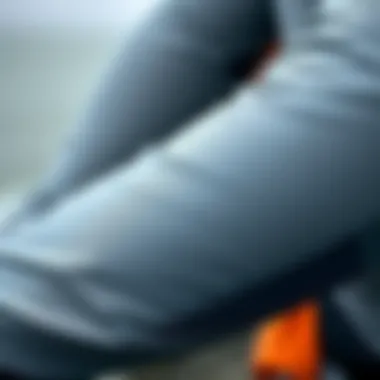
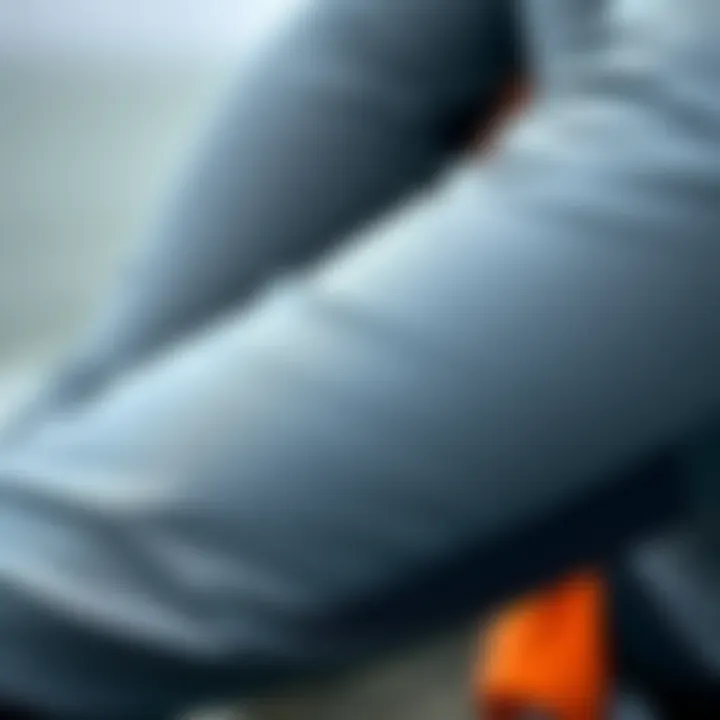
Synthetic Fabrics for Performance
Synthetic fabrics have gained traction thanks to their lightweight properties and specialized performance traits. Materials like polyester and nylon are common in kiteboarding wet shirts. Here's why:
- Breathability: Fabrics made from polyester effectively wick away moisture and allow for air circulation, helping to keep the wearer dry and comfortable.
- Quick drying: One of the biggest advantages of synthetic fabrics is their ability to dry rapidly. After a dunk in the water, a synthetic wet shirt can be ready to wear again in no time, significantly enhancing comfort between sessions.
- Customizability: Because synthetic fabrics are easy to dye and print on, patterns and colors can be changed up, allowing kiteboarders to express their unique style.
Despite all their perks, synthetic fabrics often lack the thermal insulation that neoprene offers. So, considering your local climate is key when choosing.
Natural Fibers: Pros and Cons
Natural fibers, such as cotton or merino wool, are less common in the kiteboarding scene but not without merit. The appeal of natural fibers lies in their comfort and sustainability.
- Comfort: Natural fibers generally feel softer against the skin and can be more comfortable for casual wear.
- Breathability: They tend to be quite breathable, which is great for warm-weather kiteboarding.
On the flip side:
- Natural fibers do not dry nearly as fast as synthetic ones. If they get wet, they can cling to your body, leading to a heavy and cumbersome feel while you’re on the water.
- They also typically lack the durability needed for the wear and tear that comes with kiteboarding.
In summary, while natural fibers might have certain advantages when it comes to comfort, their performance in kiteboarding scenarios leaves much to be desired.
"Choosing the right material composition is just as much about personal preference as it is about functionality. A balance between comfort, durability, and performance will keep you thriving out on the water."
Functional Features
When kiteboarding, having the right gear can make or break your experience on the water. Among the various pieces of equipment, long sleeve wet shirts stand out not just for their style but also for their functional utility. This section digs into the essential features of these wet shirts—offering kiteboarders a closer look at how specific attributes contribute to performance, safety, and comfort during their rides.
UV Protection
Exposure to the sun's harsh rays is unavoidable when kiteboarding. Long sleeve wet shirts are designed with built-in UV protection, which plays a crucial role in safeguarding the skin against harmful ultraviolet radiation. This protection is paramount as prolonged exposure could lead to skin damage or conditions like sunburn.
Many premium wet shirts boast a UPF rating, which quantifies the shirt’s ability to block UV rays. A higher UPF rating indicates superior protection. It's essential to choose a shirt with a suitable rating, especially for those spending entire afternoons carving across the waves.
Consider this a friendly reminder: although UV protection in clothing is a great line of defense, it shouldn’t replace sunscreen. In fact, applying sunscreen underneath your shirt can provide an extra layer of safety. Remember, there is no such thing as being too cautious when it comes to the skin.
Thermal Insulation
Temperature regulation is another aspect where long sleeve wet shirts shine. The dynamics of kiteboarding often mean fluctuating weather conditions, where the sun can be blazing one moment and a chilly breeze might kick in the next. Shirts made from thermal insulation materials help maintain body warmth without adding bulk.
These garments function effectively in keeping a kiteboarder cozy even during cooler tides. Materials like Neoprene or certain synthetic fabrics trap heat close to the body, allowing for movement while providing an essential layer of warmth. This insulation is beneficial not only for comfort but also for performance—when a rider is warm, their focus remains on the tricky maneuvers rather than on feeling cold or uncomfortable.
However, a balance must be struck, as overheating can become an issue. Picking the right wet shirt according to the day's weather is crucial. This prevents both chills and excessive sweating, keeping the rider in their optimal zone.
Quick Drying Properties
The nature of kiteboarding involves splashes and spills, and that’s part of the thrill. Yet, it's vital that you have gear that dries quickly after a wet session. Long sleeve wet shirts, especially those crafted from advanced synthetic fabrics, often feature quick-drying properties.
Why does this matter? A wet shirt can weigh you down and lead to discomfort during your ride. Quick drying minimizes this, allowing for a comfortable movement without becoming a boat anchor. Riders can seamlessly transition from the water back onto the board without feeling soggy or restricted.
Additionally, after a long day on the water, you might want to hang out at the beach, relax, or grab a bite to eat. No one enjoys sitting in a wet shirt. With quick-drying technology, you can change out of that water-logged gear and enjoy the rest of your day comfortably. In short, while kiteboarding is about performance, being comfortable increases enjoyment off the water too.
The fusion of functional features in long sleeve wet shirts not only enhances performance but also enables freedom and safety, allowing kiteboarders to make the most of their ride.
Performance in Kiteboarding
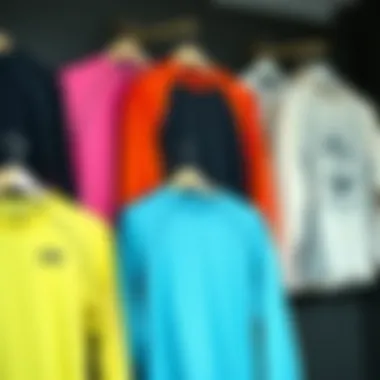

When it comes to kiteboarding, performance can often make or break the experience on the water. Long sleeve wet shirts play a pivotal role in how kiteboarders move, react, and engage with the elements. Whether you’re catching air off a wave or trying to maintain balance in choppy water, the right shirt can significantly enhance your performance.
Impact on Mobility and Flexibility
A key aspect of kiteboarding is the need for agility. Kiteboarders rely on quick movements and precise adjustments to navigate the unpredictable nature of the ocean. Long sleeve wet shirts are designed with materials that offer ample stretch, helping you to bend, twist, and turn without feeling restricted. Many options in the market today utilize fabrics such as spandex blended with neoprene, which can provide that much-needed elasticity.
In addition to the fabric choice, the cut of the shirt makes a difference. A well-tailored wet shirt fits snugly but does not cling too tightly, allowing for free movement. You can think of it like a second skin that supports your efforts rather than weighing you down. Also, features like flatlock seams can reduce chafing, so you’re not constantly adjusting your gear.
"Being able to move freely is key. If your shirt feels like a straightjacket, every trick you try can backfire!"
Resistance to Water and Wind
Another monumental factor in kiteboarding performance is how well your gear withstands the elements. Long sleeve wet shirts provide notable resistance to both water and wind, making them essential for maintaining body temperature and comfort. The materials used, such as high-quality neoprene, act as barriers against the chilling effects of wind and the constant spray of water. Instead of feeling like you’re battling against the ocean, a proper wet shirt can help keep you warm and dry, allowing you to focus on your skill set.
Moreover, advanced manufacturing techniques also create shirts with wind-resistant properties. This means that even when gusts hit you from the side, you won't feel completely exposed to the elements.
When kiteboarding in variable conditions, this dual resistance can encourage longer, more productive sessions. You remain less fatigued and focused on honing your craft. So, when selecting a long sleeve wet shirt, consider not just the aesthetics or style, but how the shirt can bolster your kiteboarding performance, making each outing more enjoyable and effective.
In sum, the interplay of mobility, flexibility, and elemental resistance found in long sleeve wet shirts makes them not just garments, but essential gear for kiteboarders aiming to elevate their experience. Choosing the right one can be the difference between slicing through the waves with ease or feeling like you’re fighting a relentless tide.
Style and Personal Expression
When we talk about kiteboarding, it’s not just about the thrill of harnessing the wind to glide over water. There's a whole world of personal expression that comes into play, and long sleeve wet shirts serve as a key canvas for that expression. They mold functionality with style, making it possible for enthusiasts to shine in their own unique way while also ensuring performance doesn’t suffer.
Trends in Kiteboarding Apparel
Over the last few years, the trends in kiteboarding apparel have seen a significant shift. There’s a palpable move towards vibrant colors and bold patterns. Kiteboarders are increasingly opting for shirts that stand out, reflecting their personalities while navigating the waves. Tie-dye designs, for instance, are making a comeback, feeding into a nostalgic style while ensuring practicality.
This trend isn’t limited to colors; the overall fit and form of long sleeve wet shirts are also evolving. Loose fits that allow for freedom of movement are becoming popular. They not only provide comfort but give a laid-back feel that many in the kiteboarding community appreciate. The collaboration among manufacturers and artists has led to limited edition collections that blend art with functionality, thus catering to a more fashion-conscious audience.
Choosing Colors and Patterns
Choosing the right color and pattern for a long sleeve wet shirt is not simply a matter of preference—it’s about making a statement. Bright and neon colors, like electric blue or fiery orange, not only look stunning but can also serve as visibility aids, particularly in dynamic water environments.
When it comes to patterns, geometric designs or nature-inspired motifs often catch the eye. However, individuals should consider the physical attributes of these patterns as well. Some patterns can enhance a person’s physique on the water, creating engaging visual effects as they move. On the other hand, solid colors provide a classic look that’s often chosen for its versatility.
Ultimately, the choices in colors and patterns reflect a kiteboarder’s personality and style. They allow for self-expression in a way that is both practical and aesthetically pleasing.
Brand Influences
Various brands play a significant role in shaping style preferences in the kiteboarding community. O’Neill, Rip Curl, and Quiksilver are just a few that often lead the pack. Each brand carries its own aesthetic, influencing what kiteboarders view as fashionable or functional. Some brands focus heavily on performance-driven designs, while others prioritize style, resulting in a vibrant mix of offerings in the market.
Moreover, social media has amplified brand influence, as riders now showcase their gear online. When kiteboarders post their outfits or gear on platforms like Instagram or Facebook, they are often setting trends themselves, pushing brand loyalty and peer influence.
"Style is a way to say who you are without having to speak."
– Rachel Zoe
Care and Maintenance
The longevity and performance of long sleeve wet shirts are significantly influenced by how well they are cared for and maintained. Neglecting these garments can lead to a decline in their technical qualities and overall appearance, which in turn affects a kiteboarder’s experience on the water. Ensuring that these shirts remain in optimal condition involves understanding specific care techniques and the best practices for storage.
Washing Techniques
When it comes to washing long sleeve wet shirts, a little care goes a long way. Always start by rinsing the shirt in fresh, cool water immediately after use. This step helps remove salt water, sand, and any other debris that may have accumulated during your session. Using a gentle detergent specifically designed for technical fabrics is advisable. Avoid bleach and fabric softeners, both of which can damage the material and impair its functionality.
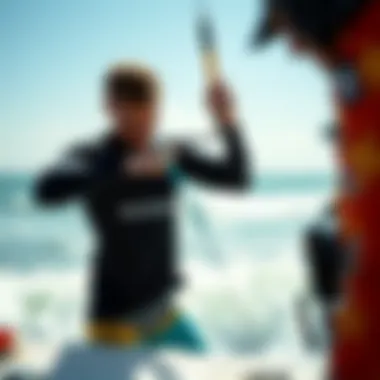
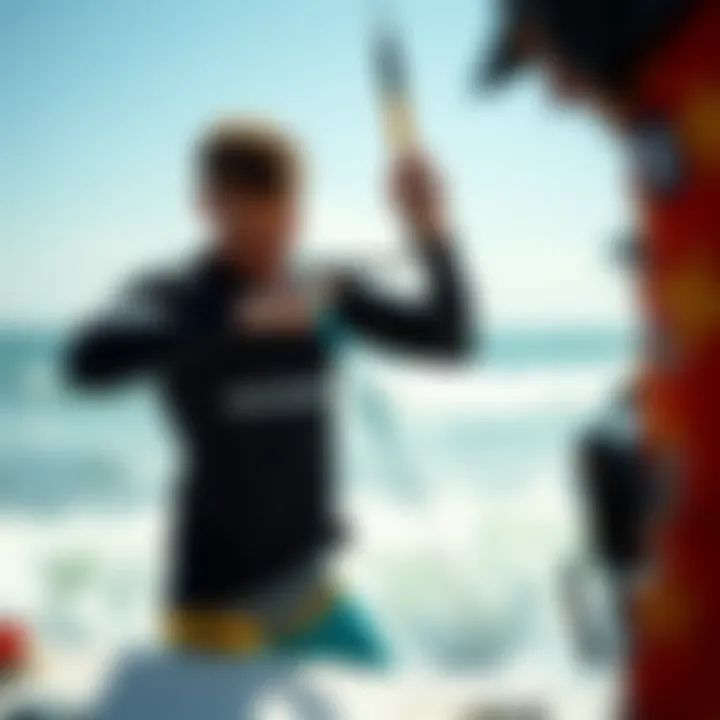
- Hand Washing: When washing by hand, fill a basin with cool water, add the recommended amount of detergent, and gently agitate the fabric. Let it soak for about 10 to 15 minutes before rinsing thoroughly until the water runs clear.
- Machine Washing: If machine washing, opt for a delicate cycle and place the shirt in a mesh laundry bag to limit friction with other garments. Set the machine to cold water to prevent any shrinkage or color fading.
After washing, it’s important not to wring the shirt out aggressively as this can distort its shape. Instead, press the water out gently and lay the shirt flat on a clean towel. Never put your wet shirt in a dryer; air drying is the safest way to maintain its structure and elasticity.
Storage Suggestions
Proper storage is just as crucial as washing for maintaining the integrity of long sleeve wet shirts. Folding and hanging are two common methods, but each has its pros and cons.
- Hanging: If you choose to hang your wet shirt, use broad, padded hangers. This helps prevent stretching and maintains the shirt’s shape. However, be mindful of the space it’s taking; crowded hangers can cause warping.
- Folding: Folding is often recommended for long-term storage, especially to avoid stretching. Ensure that the shirt is completely dry before folding to prevent mildew. Store it in a cool, dry place, and consider wrapping it in a breathable fabric to allow air circulation.
Some kiteboarders find it beneficial to keep their shirts in a designated sports bag. This keeps them away from excessive sunlight, which can deteriorate fibers over time. It also helps avoid mixing with everyday clothing, minimizing potential wear and tear.
In summary, the care and maintenance of long sleeve wet shirts are essential for preserving their functionality and aesthetics.
For more detailed care instructions, you can refer to the fabric care guidelines on Wikipedia or consult with brands like Patagonia known for their expertise in technical apparel.
Environmental Considerations
As the world becomes more aware of the impact of human activities on our planet, the discussion about sustainable practices in various industries, including kiteboarding, has stepped into the spotlight. Long sleeve wet shirts, while they serve essential functions in terms of performance and comfort, also need to be considered through the lens of environmental consciousness. Kiteboarders not only seek gear that can withstand the elements but also appreciate apparel that aligns with eco-friendly values.
To address this, we can break down two crucial components of environmental considerations: sustainability in materials and ethical production practices. Recognizing these aspects not only aids in making informed choices but also empowers kiteboarders to actively support initiatives that promote the well-being of our environment.
Sustainability in Materials
In kiteboarding, the right materials can make a significant difference. Traditional materials used in wet shirts, like standard neoprene, often have a hefty carbon footprint due to their production processes. However, the introduction of sustainable alternatives is slowly taking the market by storm. Materials engineered with eco-friendliness in mind serve dual purposes—providing function while reducing harm to the environment.
Many brands now offer wet shirts made from recycled plastics or bio-based materials. Recycled polyester, for instance, derived from post-consumer plastic bottles, is gaining ground for its resilience and low environmental toll in production. On the other hand, some companies are experimenting with natural and biodegradable materials, like organic cotton blends, which, although less common, show promise for the environmentally conscious kiteboarder.
When selecting a long sleeve wet shirt, consider the following:
- Source of Materials: Check for certifications, such as Global Recycled Standard (GRS) or OEKO-TEX, which assure less environmental impact.
- End-of-Life Options: Preferring brands that offer take-back programs or recycling initiatives ensures that the product does not contribute to landfill waste after its life.
This shift towards sustainable materials means that kiteboarders don't have to sacrifice style and performance for eco-consciousness. These materials often incorporate technologies that enhance thermal insulation and moisture-wicking properties, aligning perfectly with the functional needs of enthusiasts.
Ethical Production Practices
The fabric of kiteboarding clothing extends beyond just the materials used; it envelops the entire production process. Awareness around labor practices has led to a demand for ethically produced products that uphold workers' rights and ensure fair conditions. Just like how kiteboarders think about the gear that supports their performance on the water, they should also reflect on the ethics of how that gear is made.
Ethical practices can range from fair wages and safe working conditions to minimizing carbon output during manufacturing. Shoppers should exercise diligence; looking into brands that share their commitment to sustainability not only drives responsible sourcing but also encourages others in the industry to follow suit.
Key points to consider include:
- Transparency: Brands should openly share their production methods and labor conditions.
- Local Production: Choosing products made locally not only reduces the carbon footprint associated with shipping but often supports community economies.
- Certifications: Look for ethical certifications, such as Fair Trade Certified or B Corporation, which evaluate companies on social, environmental, and community impact.
Choosing to support ethically produced gear fosters an industry culture that prioritizes responsibility over profit, reinforcing the understanding that kiteboarding can coexist with environmental stewardship.
By considering sustainable materials and ethical production practices, kiteboarders can enjoy their sport with the knowledge that their choices contribute positively to the environment and community. When these values are woven into the very fabric of what we wear, we not only enhance our experience on the water but also contribute to a healthier planet.
Finale
In the expansive world of kiteboarding, long sleeve wet shirts hold a significant place, marrying function and aesthetics in ways that enhance the overall experience of the sport. The importance of these garments cannot be overstated, as they serve not only as a protective layer against the elements but also as a canvas for personal expression and style.
When considering the technical advantages, long sleeve wet shirts offer vital UV protection, safeguarding practitioners from harmful sun rays. This is particularly crucial for those spending extended periods on the water, where the risk of sunburn skyrockets. Additionally, the thermal insulation provided by specific fabric compositions ensures that kiteboarders remain warm in cooler conditions, making it possible to participate in the sport comfortably year-round.
The aesthetics of these shirts contribute to a kiteboarder's identity on the water. With a variety of colors, patterns, and designs to choose from, riders can express their personality and style while aligning with current trends. The choice of brand also plays a role, as some names have become synonymous with quality and innovation in the kiteboarding community, influencing the decisions of many enthusiasts.
Furthermore, as kiteboarding gains popularity, the aspect of sustainability in the materials used for long sleeve wet shirts has become paramount. Kiteboarders today are increasingly conscious of their environmental impact. Brands that prioritize ethical production practices and sustainable materials are not only appealing to the eco-conscious consumers but also setting a standard for the industry.
In revisiting the holistic role of long sleeve wet shirts, we recognize them as an essential part of kiteboarding gear. Their functionality, combined with the ability to express individuality, makes them a key component of any kiteboarder's wardrobe. By understanding these elements, practitioners can make informed choices that enhance both their safety and enjoyment on the water. To sum up, wearing the right long sleeve wet shirt is a step towards embracing the sport fully, ensuring comfort, safety, and style—all while riding the exhilarating waves.







